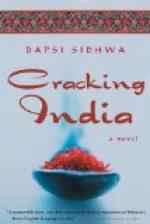|
This section contains 810 words (approx. 3 pages at 300 words per page) |

|
SOURCE: Edwards, Kamala. “Cracked Identities.” Belles Lettres 7, no. 1 (fall 1991): 47-8.
In the following review, Edwards compliments Cracking India for its incisive and poignant depiction of the Partition of India.
In Bapsi Sidhwa's novel Cracking India, the reader encounters a richly textured, multicultural society suddenly in flux. Within three months, seven million Muslims and five million Hindus and Sikhs find themselves uprooted in “the largest and most terrible exchange of population known to history.” But the 1947 partition made Hindus, Muslims, and Sikhs each other's enemies, overnight. Subsequently, “one man's religion became another man's poison,” and religious affiliations and national identity emerge as crucial points of conflict in the novel.
Memories of partition surface in all three of Sidhwa's novels, but are nowhere as penetrating and poignantly recalled as in Cracking India. The narrator, Lenny, a polio-stricken Parsee, finds that she has become a “Pakistani in a snap. Just like...
|
This section contains 810 words (approx. 3 pages at 300 words per page) |

|


